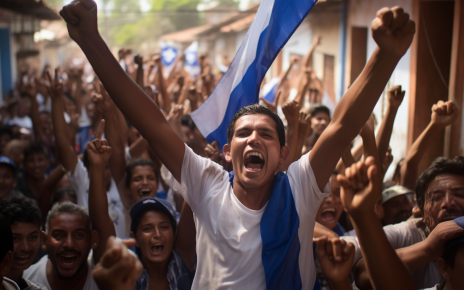In a unique comparison, two distinct revolutions from different corners of the world have been dubbed as ideological twins by their leaders, marking a curious parallel in their tumultuous histories.
The upheavals in the heart of Iran and the depths of Nicaragua, although born from the ashes of oppressive regimes in 1979, took starkly diverse trajectories. While one heralded the rise of extremist clerics pushing a radical Islamic agenda, the other saw the ascent of Marxist revolutionaries claiming to champion the people.
The economic aftermath of these revolutions was equally turbulent, as both Iran and Nicaragua spiraled into chaos post-dictatorship, showcasing the unforeseen consequences of toppling autocratic regimes.
Expressing vehement animosity towards the United States, the Iranian ayatollahs labeled the nation as the «great Satan,» illustrating a deep-seated enmity that transcended borders. Meanwhile, the Nicaraguan revolutionaries condemned the northern democracy as an «enemy of humanity,» mirroring a sentiment of defiance.
Despite their shared disdain for democratic principles, the paths of Iran and Nicaragua diverged in a critical juncture, with the latter briefly embracing democratic norms before reverting to autocratic rule in a bid to retain power.
Not confined to their individual struggles, these regimes form part of a broader international fraternity characterized by authoritarian rule. Under the shadow of dominant powers like Russia and China, these nations seek to challenge the established global order, posing a formidable challenge to Western democracies.
In a profound exploration of the divergent paths undertaken by ideological twins, the narratives of Iran and Nicaragua reveal intricate layers of complexity that shape the global political landscape.
Amidst the echoes of revolution, one key question emerges: What were the underlying social, historical, and geopolitical factors that propelled Iran towards radical Islamism and Nicaragua towards Marxism despite their initial shared struggle against oppressive regimes? The answer lies in the unique contextual dynamics of each society, influenced by historical grievances, religious fervor, and external interventions.
A crucial aspect that distinguishes these ideological twins is their approach to governance and human rights. While Iran’s theocratic regime imposed strict religious laws and suppressed dissent, Nicaragua initially embraced democratic ideals following the Sandinista revolution. How did these contrasting trajectories in governance impact the socio-political fabric of their respective societies? The complex interplay between ideology, power dynamics, and socio-economic realities holds the key to understanding the divergent paths taken.
One of the key challenges associated with the ideological twins lies in reconciling revolutionary ideals with the pragmatism of governance. How do these regimes navigate between ideological purity and the demands of governance, especially in the face of internal dissent and external pressures? The balancing act between revolutionary zeal and political pragmatism shapes the contours of their domestic policies and international relations.
An inherent advantage for these ideological twins is their ability to mobilize popular support by tapping into historical grievances and nationalist sentiments. By framing their struggles as a battle against imperialism and external interference, Iran and Nicaragua have cultivated a sense of national identity and resilience among their populace. This grassroots support serves as a bulwark against internal dissent and external interventions.
However, a notable disadvantage stems from the isolation and alienation that these regimes face on the global stage due to their confrontational stance towards the West. How do Iran and Nicaragua navigate the politics of international diplomacy and economic sanctions while upholding their revolutionary ethos? The trade-off between ideological purity and economic pragmatism poses a fundamental dilemma for their long-term stability and development.
For a comprehensive understanding of the ideological twins and their impact on the global order, the United Nations website provides valuable insights into the principles of international cooperation and conflict resolution. Exploring the role of non-state actors and transnational alliances in shaping world politics can shed light on the complexities of ideological competition and cooperation in the contemporary era.



